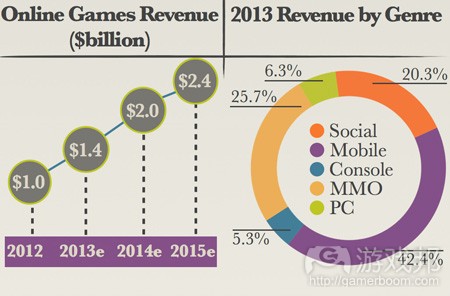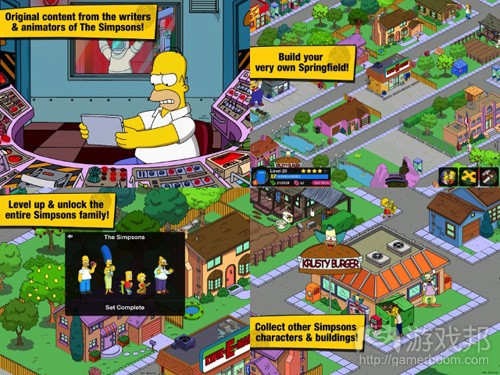每日观察:关注巴西手机游戏市场规模等消息(10.30)
1)市场调研公司SuperData最新数据显示,2012年巴西游戏市场规模达10亿美元,预计2013年将增长至14亿美元。
其中手机游戏是最大的市场,在2013年总收益中将占比42%(即5.8亿)。
SuperData还预测,手机游戏月活跃用户约1.15亿(该国人口为2亿)。
2)Gartner最近报告预测,手机游戏已经成为电子游戏行业发展最快的领域,2013年收益将达132亿美元,预计2015年将增长至220亿美元。
报告指出,随着移动设备市场份额及技术的不断发展,手机游戏将成为发展最大的游戏领域。
2013年整个游戏市场规模将达930亿,预计2015年将增长至1110.57亿美元。
3)据pocketgamer报道,中国游戏行业股市最近面临挑战,畅游[NASDAQ: CYOU]和空中[NASDAQ: KONG]这两家发行商股价下挫明显,前者下跌20%,市值缩水3.8亿美元,后者下跌也达到18%。
与此同时中国手游娱乐集团股价下滑8%,盛大游戏股票降幅为6.6%,网易下降10%。
除此之外,百度和奇虎360等平台公司也分别下滑3%。分析称出现这一情况的原因包括这些公司最近公布了第三季度财报,此外有些股票已经接近52周以来的历史最高点,可能有些投资者正着手将股票套现。
与此同时,美国手机游戏发行商Glu Mobile股票却上涨了12%。
4)据pocketgamer报道,EA日前公布其2013财年第二季度(截止9月30日)财报,指出该季度公司收益为6.95亿美元,同比上年下降2%,净亏损为2.73亿美元(去年同期亏损达3.81亿美元)。
EA Mobile在该季度销售额为7500万美元,与去年同期持平,但比第一季度下降34%。
其中《The Simpsons:Tapped Out》销售额达1亿美元,《植物大战僵尸2》在iOS下载量为2500万次,《实况赛车3》月活跃用户达1800万。
5)据gamasutra报道,手机游戏开发者Erik Asmussen最近发表博文指出,iOS游戏市场竞争太激烈了,即使是成功的游戏也难以实现盈利,过去很管用的曝光渠道(游戏邦注:例如媒体报道、苹果推荐、免费促销活动)已经失去效用,即便开发者占据天时地利,也不一定能保证收益。
他以自己的游戏《PWN: Combat Hacking》(以下简称PWM)为例指出,该游戏目前下载量为5万次,总收益约1万美元,最高峰时曾跻身苹果App Store前200名榜单,每天收益为300-400美元。
如果游戏保持这种势头也许能取得理想结果,但如果没有App Store的持续推荐,或者庞大的下载基础,游戏就很难维持目前的排名。该游戏发布时取得了较良好的媒体评价,但排名很快就下滑了,无论多少次更新和免费促销都无济于事。
而免费应用市场竞争则更为激烈,因为所有大型发行商都在砸钱做营销推广,小型开发者根本难以招架。因此Asmussen表示自己已经不再将iOS视为关注重心,而是使用Unity开发游戏首先瞄准其他平台。
6)据venturebeat报道,Nexon首席财务官Owen Mahoney在最近的GamesBeat 2013大会上指出,免费手机游戏开发者应该致力于制作好游戏,而不是垃圾。他称开发者应该以自己进入这一行就是因为热爱游戏的心态来
创作,但App Store中却有许多开发者只是追求最快赚钱的捷径,从而衍生出大量模仿剽窃之作。
他认为《英雄联盟》就属于不仅仅着眼于盈利性,而是专注于创造出色体验,让玩家长期在游戏中逗留的典型。玩家在游戏中的时间越长,就越有可能为之掏钱。
7)据venturebeat报道,游戏行业元老Trip Hawkins日前在GamesBeat 2013演讲中指出,女性是家庭科技、娱乐设备的购买者,也是家庭媒体的管理理,行业应重视这一群体的作用和影响。
因此,游戏发行商若要接触少儿群体,就得通过“妈妈博客”等途径,先做通妈妈群体的思想工作。
Animoca首度官David Kim认同Hawkins的观点,并补充道广告商尚未充分挖掘其中的市场潜力,目前游戏中的广告主要是推广另一款游戏,却不擅于利用这种机会针对妈妈群体推广一些家用洗碗机等生活用品。(本文为游戏邦/gamerboom.com编译,拒绝任何不保留版权的转载,如需转载请联系:游戏邦)
1)Chart of the Week: Brazil’s $580 million mobile gaming market
by Jon Jordan
There’s no question that there are a lot of large, emerging markets for mobile games.
Recently, we considered China’s in a world context, and then we went on to ponder the potential of India, Indonesia and Thailand.
But what about the world’s fifth largest population, a founding member of the so-called BRICS – Brazil?
Samba beat
According to information from research company SuperData, the Brazilian games market in 2012 was worth $1 billion, which is estimated to rise to $1.4 billion in 2013.
Significantly, it reckons mobile gaming is the biggest sector; accounting for as much as 42 percent of revenue – $580 million in 2013.
SuperData also predicts there are around 115 million monthly active mobile gamers; that’s out of a population of 200 million.(source:pocketgamer)
2)Mobile game revenue set to double to $22 billion
by Phil Tottman
Xbox, Playstation and WiiU should watch their backs as more gamers go mobile.
Mobile gaming is the fastest growing segment of the video game market, as revenues are expected to double from $13.2 billion this year to $22 billion in 2015, reports Gartner.
It is thought that this rapid growth has been driven by global mobile sales, which CCS Insights predicted to hit 1.86 billion this year.
Not only that, but these devices are becoming increasingly sophisticated, offering progressively higher quality gaming experiences that aren’t far off the quality of the high-end consoles.
These results have come as Sony, Microsoft and Nintendo release their next-generation consoles, to a market that is possibly moving in a new direction when it comes to gaming.
The NDP Group recently reported that 53 per cent of kids a gaming more on a mobile now compared to a year ago.
Brian Blau, research director at Gartner, said: “As mobile devices (smartphones and tablets) continue to grow, the mobile game category will show the biggest growth due to the entertainment value provided by games compared with other app categories.”
The gaming market overall is set to reach $93 billion, and is expected to hit a whopping $111,057 billion in 2015.
The result focus on video game consoles, handheld video games, mobile games, and PC games – with handhelds such as the PSP Vita and Nintendo 3DS and 2DS being the only sector predicted to decline from 18,064 this year to 12,399 in 2015.
A large portion of growth in mobile games has come from emerging markets, who are no longer replacing old PC’s with new ones, but with tablets, and have more access to smartphones than they do handheld games.
Not only that but mobile games are considerably cheaper than those in all other sectors of the market, making it more appealing.
Mr Blau continued: “Moving forward, game developers will need to constantly deliver compelling games as the growth of content and platform choices drives game players in divergent directions.” (source:mobile-ent)
3)Blood on the tracks: Chinese game stocks hit hard as market sentiment weakens
by Jon Jordan
As if to underline the challenges of the Chinese games market, the start of the week has seen strong falls on some company stocks.
Changyou [NASDAQ: CYOU] and KongZhong [NASDAQ: KONG] – two online and mobile publishers – were hit especially hard.
Changyou shares were down 20 percent, losing around $380 million of market cap, while KongZhong dropped over 18 percent.
Meanwhile, China Mobile Games & Entertainment group [NASDAQ: CMGE] saw its shares down over 8 percent, Shanda Games [NASDAQ: GAME] was down 6.6 percent, and NetEase [NASDAQ: NTES] was down over 10 percent.
In total, around $2 billion was wiped off the value of Chinese gaming companies.
Down, down
Significantly, this downward pressure was seen across the majority of Chinese technology stocks floated on the US NASDAQ and NYSE exchanges.
This included platform companies such as Baidu [NASDAQ: BIDU] and Qihoo 360 [NASDAQ: QIHU], both down over 3 percent.
It’s currently the season for companies to report their financials for the three months ending 30 September 2013. Consumer sentiment from China has been hit by weak sales of consumer goods such as cars and liquor; something that seems to have been passed onto gaming stock.
Another factor is that some stocks have been near their 52-week highs, suggesting some investors might be banking their gains.
Conversely, however, troubled US mobile games publisher Glu Mobile [NASDAQ: GLUU] saw its share rise 12 percent.(source:pocketgamer)
4)EA Mobile stutters with Q2 FY14 sales down 34% to $75 million
by Jon Jordan
EA (NASDAQ: EA) has announced its preliminary Q2 financials for the three months ending 30 September 2013.
Revenue was $695 million, down 2 percent year-on-year.
The company made a net loss of $273 million, compared to a loss of $381 million 12 months ago.
Breaking out EA Mobile’s performance, it generated sales of $75 million during the quarter.
This is same as 12 months ago and down 34 percent compared to Q1 FY14.
This is despite the company announcing The Simpsons: Tapped Out has generated $100 million in lifetime sales, Plants vs. Zombies 2 has been downloaded 25 million times on iOS, and that Real Racing 3 has 18 million monthly active users.
No shelf space
As ever, EA pointed to its growing slice of digital games sales in order to demonstrate its ability to meet current and future market trends.
Across the board, net revenue from digital sales was $450 million, up 39 percent year-on-year.
“EA’s strong second quarter was driven by great title launches, continued digital growth, and financial discipline,” said new CEO Andrew Wilson.
“While we have made good progress in the first half of the year, we remain focused on executing our FY14 plan and delivering a full slate of amazing games and services to players on current and next-generation consoles, mobile, and PC.”
Cash out
In terms of cashflow, over the past 12 months, EA generated $342 million, down 30 percent year-on-year.
The company ended the quarter with cash, equivalents and short-term investments worth $1.4 billion, up $7 million compared to the previous quarter.(source:pocketgamer)
5) Why one developer decided he was done with the iOS App Store
By Kris Ligman
In a postmortem of his game PWN: Combat Hacking printed on Pocket Tactics, mobile developer Erik Asmussen says the iOS market has become too crowded for even a successful title to pay dividends.
“Many things that used to work (press, Apple feature, free promotions) have lost effectiveness,” Asmussen writes. “Even when all these things fell miraculously into place, the revenues simply weren’t there.”
To date, PWN has seen 50,000 downloads and a lifetime revenue of about $10,000. Asmussen says that, at PWN’s peak position within the top 200 on the Apple app store, the game was earning about $300 to $400 a day.
“This would be great if sustained, but hanging on to these spots is nearly impossible without an ongoing feature in the App Store or a huge install base,” he explains. “The scary thing is that these numbers are actually pretty good for an iOS title.”
While the game garnered better-than-typical press attention upon release, middling reviews and certain design quibbles caused PWN to drop off the radar shortly after launch, and no amount of updates and free promotions could regain that lost ground.
“The free app market is [arguably] even tougher to compete in, because all the big money players are now staked out there and it takes a massive ad spend to get anywhere close to the number of players you might need to get decent revenue,” says Asmussen. “While [PWN's performance is] not a disaster, it’s a pretty weak return given a year’s worth of time and my expectations for the game’s potential.”
As a result, Asmussen says he’s now focusing his efforts elsewhere than the app store. “iOS is just not a market that I think is viable for me to compete in any more, let alone depend on as a sole source of income. Instead, I am developing games using Unity and targeting several other platforms first.”
“The most important benefit of this shift is that it opens up a ton of new avenues for promotion and distribution that were unavailable to me as an iOS developer,” he adds. “I know these markets are still highly competitive and have their own problems and obstacles, but they don’t feel like the dead end that iOS appears to be now for someone in my position.”(source:gamasutra)
6)Nexon CFO’s advice to free-to-play mobile developers: Don’t make junk
Kat Bailey
GamesBeat 2013 — our fifth annual event on disruption in the gaming industry — is underway! Check out the live video feed and full event coverage
REDWOOD CITY, Calif. — Nexon chief financial officer Owen Mahoney has some simple advice for free-to-play mobile developers looking to make it big: Make good games.
Such advice may seem self-evident, but Mahoney feels too many mobile developers are eager to cash in on the latest App Store trend.
“Our message is: Don’t make junk. You got into the games business because you love games,” Mahoney said during a GamesBeat 2013 fireside chat covering the growing influence of Asian game developers on the U.S. industry. “A lot of what you see in the App Store is based on a fast-follower strategy. And fast follower is really a euphemism for copycat.”
In other words, while it’s tempting to prioritize a strong monetization strategy over good, solid gameplay, the truth is that the two feed into one another. The more immersive the game, Mahoney feels, the more likely players are to keep playing long-term. And the longer they play, the more likely they are to spend money.
As it continues to try to build on its presence in Western markets, Nexon hopes to apply some of those lessons to its own games. A large free-to-play developer originally founded in Korea, Nexon is eager to develop a truly international presence. Now that titles like the immensely successful free-to-play arena game League of Legends have broken out in the U.S., Nexon sees what Majoney calls a “massive opportunity” in the West.
League of Legends happens to be the exemplar of Mahoney’s philosophy on free-to-play: “The brilliance of [League of Legends] is that they didn’t just focus on monetization. Really, free-to-play is about focusing on creating a great experience and keeping players in that great experience for as long as possible.”
Such in-depth free-to-play experiences have largely been confined to PC at this point, but that doesn’t need to be the case, said Mahoney. The technical gap between the PC and mobile devices is smaller than ever, giving rise to the potential for in-depth free-to-play games on phones and iPads.
With that, Majoney hopes the mindset among Western free-to-play and mobile developers will begin to shift: “When you think of mobile devices, you mostly think of casual games. But you can make a very immersive experience. When you do that, the metrics are as good as they are on PC.”
As for Nexon, Mahoney envisions his studio spearheading a future in which the Eastern free-to-play philosophy is matched with high-quality Western game design.
Whatever that ultimately entails, Mahoney hopes that Nexon isn’t alone in its aspirations: “I hope Western gamemakers continue to pursue free-to-play in a passionate way. And don’t copy stuff. Because copying stuff is the road to bad business.”(source:venturebeat)
7)Trip Hawkins: Women have taken over tech purchasing, and video games are next
Dylan Tweney
GamesBeat 2013 — our fifth annual event on disruption in the gaming industry — is underway! Check out the live video feed and full event coverage.
REDWOOD CITY, Calif. — Serial video game executive Trip Hawkins has his eye on a new market: women.
“For the first time in history, women have taken over technology-buying for their families,” Hawkins said on a panel discussion about mobile advertising at GamesBeat 2013, VentureBeat’s annual game industry conference.
This development is only a couple of years old, said Hawkins, who founded gaming giant Electronic Arts and Digital Chocolate and who now runs London-based studio If You Can. Traditionally, manufacturers segmented home appliances into two categories: “white goods” for the kitchen and laundry room, such as dishwashers and blenders (bought by women) and “black goods” for the living room and den, such as video game consoles and TVs (bought by men). But that’s changed, starting with the advent of the iPhone and iPad, Hawkins said. Now moms are the primary purchasers of electronics for their families, and they’re also the ones who manage their families’ media. (Women also spend more than men on virtual goods in games.)
“This is a really big social-cultural change, and it’s going to open up dozens of new markets — both for the women and for their kids,” Hawkins said.
For instance, game publishers who want to reach underage users could advertise to their mothers via “mommy blogs,” Hawkins suggested.
Animoca chief executive David Kim, who was also on the panel, agreed with Hawkins.
“I’m surprised more game developers haven’t caught on to the whole ‘women’ genre and the strength of it,” Kim said. ”There’s definitely a more steady buying power [from female players] that we’re noticing in our own games.”
Kim also pointed out that brand advertisers haven’t yet exploited mobile-social games. Right now, most ads that appear in these games are for other mobile-social games. In the future, however, brands that want to reach specific demographics will be able to target these games — so the day may soon come when moms playing Candy Crush Saga will see ads for General Electric dishwashers.
As for the rest of the industry, Hawkins repeated the classic advertising advice: Get in front of your customers wherever they already are.
For instance, Hawkins said, ”What preteen kids are doing is looking at a lot of YouTube videos. They really get into it.” So if your game encourages kids to share YouTube videos or has created an ecosystem of related YouTube videos (like this hilarious Minecraft video), that’s a good thing.
Another place to find customers: mobile-messaging platforms like WeChat and Kik. These are already seeing heavy use from many consumers, so building games — and game advertising — on top of these platforms makes perfect sense.(source:venturebeat)















































